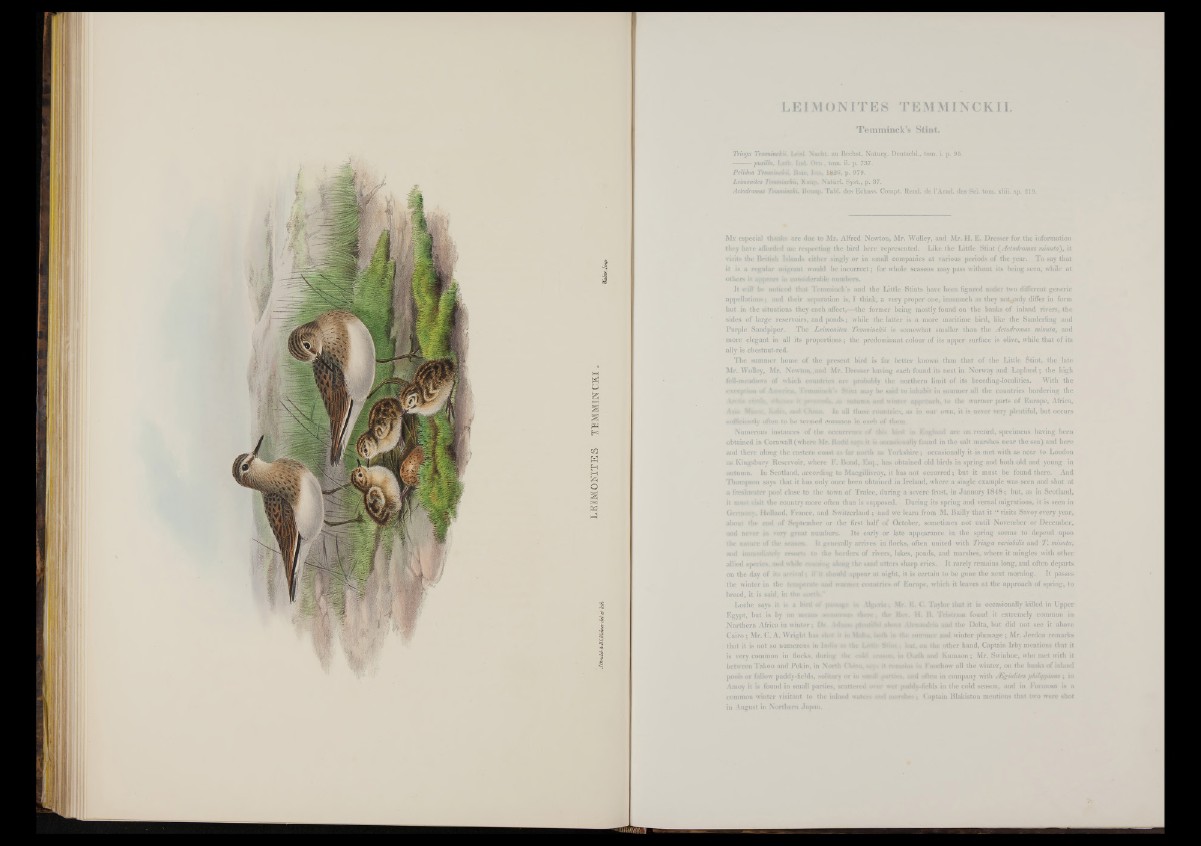
tE IM O O T T E S TEMMIBTCXI „
LEIMONITES TEMMINCKI I.
Temminck’s Stint.
Tringa Temminckn, Lewi. Nacht, za Bechst. Naturg. Deutsch!... tom. i. p. 95.
— pusilla, Lath. Ind. Ore , tom. ii. p. 737.
Pelidna T em m in e lc ii, Boie, Ism, 1326, p. 979.
Leimonites Temmmckii, Kaup, NatlirL Syst., p. 37.
Actodroimu Temmincki, Bonap. Tabl. des Echass. Compt. Rend, de I’Acad. des Sei. tom. xliii. sp. 219.
My especial thanks arc due to Mr. Alfred Newton, Mr. Wolley, and Mr. H. E. Dresser for the information
they have afforded roe respecting; the bird here represented. Like the Little Stint ( Aclodromas minuta), it
visits the British Islands either singly or in small corapauies at various periods of the year. To say that
it is a regular migrant would be incorrect; for whole seasons may pass without its being seen, while at
others it appears in considerable numbers.
I t v/iiF be noticed that Temminck’s and the Little Stints have been figured under two different generic
appellations; and their separation is, I think, a very p roper one, inasmuch as they not only differ in form
but in the situations they each affect,—the former being mostly found on the banks of inland rivers, the
sides of large reservoirs, and ponds; while the latter is a more maritime bird, like the Sanderling and
Purple Sandpiper. The Leimonites Temminckii is somewhat smaller than the Actodromas minuta, and
more elegant in all its proportions; the predominant colour o f its upper surface is olive, while that of its
ally is chestnut-red.
The summer home o f the present bird is far better knowu than that o f the Little Stint, the late
Mr. Wolley, Mr. Newton,.and Mr. Dresser having each found its nest in Norway and Lapland; the high
fell-meadows of which countries are probably the northern limit o f its breeding-localities. With the
exception o f Aewrica, TemuuBek* Stint may he said to inhabit in summer all the countries bordering the
Awtac < i: U ¡ptoeotdk* m autumn and winter approach, to the warmer parts of Europe, Africa,
Asia > .:'H■■■:, and Ourni. In all those countries, as in our own, it is never very plentiful, but occurs
sufficiently often to be termed common in each of them.
Numerous instances o f the occurrence o f W d in Eogiaud are on record, specimens having been
obtained in Cornwall (where Mr. Rodcl rays it is occasionally found in the salt marshes near the sea) and here
and there along the eastern coast as far north as Yorkshire; occasionally it is met with as near to London
as Kingsbury Reservoir, where F. Bond, Esq., has obtained old birds in spring and both old and young in
autumn. In Scotland, according to MacgilKvray, it has not occurred; but it must be found there. And
Thompson says that it has only once been obtained in Ireland, where a single example was seen and shot at
a freshwater pool close to the town o f Tralee, during a severe frost, in January 1848; but, as in Scotland,
it must visit the country more often than is supposed. During its spring and vernal migrations, it is seen in
G e ri;r\--, Holland, France, and Switzerland ; and we learn from M. Bailly'tbat it “ visits Savoy every year,
about the end of September or the first half o f October, sometimes not until November or December,
and never in very great numbers. Its early or late appearance in the spring seems to depend upon
the nature o f the season. It generally arrives in docks, often united with Tringa wriabilis and T. minuta,
and immediately resorts to the borders of rivers, lakes, ponds, and marshes, where it mingles with other
allied species, and .while running along the sand utters sharp cries. I t rarely remains long, and often departs
on the day of its arrival; if it should appear at night, it is certain to be gone the next morning. It passes
the winter in the temperate and warmer countries of Europe, which it leaves a t the approach o f spring, to
breed, it is said, in the worth,’’
Loche savs it is a bird o f passage i*» Algeria; Mr. E. (X Taylor that it is occasionally killed in Upper
Egypt, but. is by no means ««utcro«* th e re ; the fivv. H. 8. Tristram found it extremely common in
Northern Africa in win ter. Dr. Adams about Ak-xandfia and the Delta, but did not see it above
C a iro ; Mr. C. A. Wright has shot it in Matte, htdb in the summer and winter plumage; Mr. Jerdon remarks
that it is not so numerous in India as the Lotie -Sti»*; hut, on the other hand, Captain Irby mentions that it
is very common in flocks, daring the coki in Oudb und Kumaon; Mr. Swinhoe, who met with it
between Takoo and Pekin, in North China, m m ¡' re»»ama in Foochow all the winter, on the banks o f inland
pools o r fallow paddy-fields, solitary* or in sowsk parties, and often in company with AEgialitesphilippinus ; in
Amoy it is found in small parties, scattered over wet paddy-fields in the cold season, and in Formosa is a
common winter visitant to the inland waters and marshes; Captain Blakiston mentions that two were shot
in August in Northern Japan.